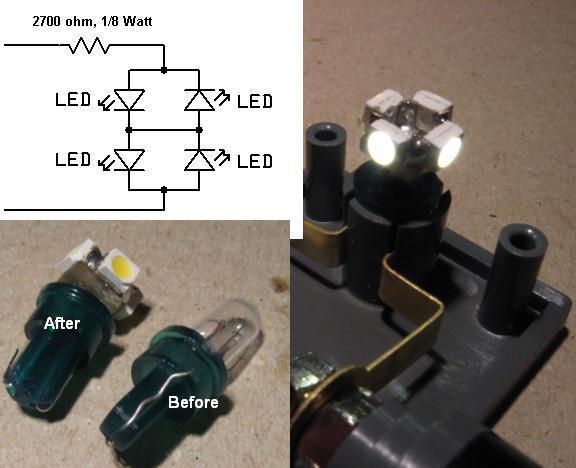Originally Posted by stan2004:
Originally Posted by cjack:
I have some Bi level cars that have 3 or 4 grain of wheat bulbs plugged into connectors along the roof. And one bulb over the lower level. I'm thinking that I could plug in some warm flat top LEDs where the bulbs were plugged in and power them with a GRJ rectifier/regulator module. Saving redoing the bulb strip under the roof. The LEDs are 10000 mcd and 120 degrees spread which converts to about 32 lumens. I wonder if just 3 or 4 of these LEDs will be bright enough. Anybody do this...?
If you don't alter the existing bulb strip, doesn't this mean you are connecting the LEDs in "parallel" with all LEDs presented the same ~3V DC. At 20 mA per LED to reach the stated brightness, that's 80 mA for 4 LEDs. GRJ will chime in but I believe that's beyond the operating range for his module.
32 lumens for a single "standard" 3mm LED seems quite high to me but let's take that at face value. What would 4 LEDs x 32 = 128 lumens look like in a passenger car? Small incandescent bulbs as used in our passenger cars might put out, say, 5 lumens per Watt. So it would take 25 Watts of incandescence to generate 128 lumens. Many passenger cars would melt with 25 Watts going in. I'd say 128 lumens would be more than enough!
That does sound like more than enough light. The boards are capable for 45 ma, so if I just use one board, I would set it for about 40 ma and would have adequate light. I guess I'll have to try it.
As to the lumens, I didn't do the math, I just found a calculator like this one when I was refreshing my understanding of lighting units...
http://www.rapidtables.com/cal...lumen-calculator.htm
Most of the 5mm LEDs available seem to spec 10000 to 15000 mcd. Not sure what they really are...maybe.
The other issue is that the LEDs have kind of rectangular pins and I wanted to see if I could just plug them in to the sockets Lionel is using for the tiny grain of wheat bulbs.






